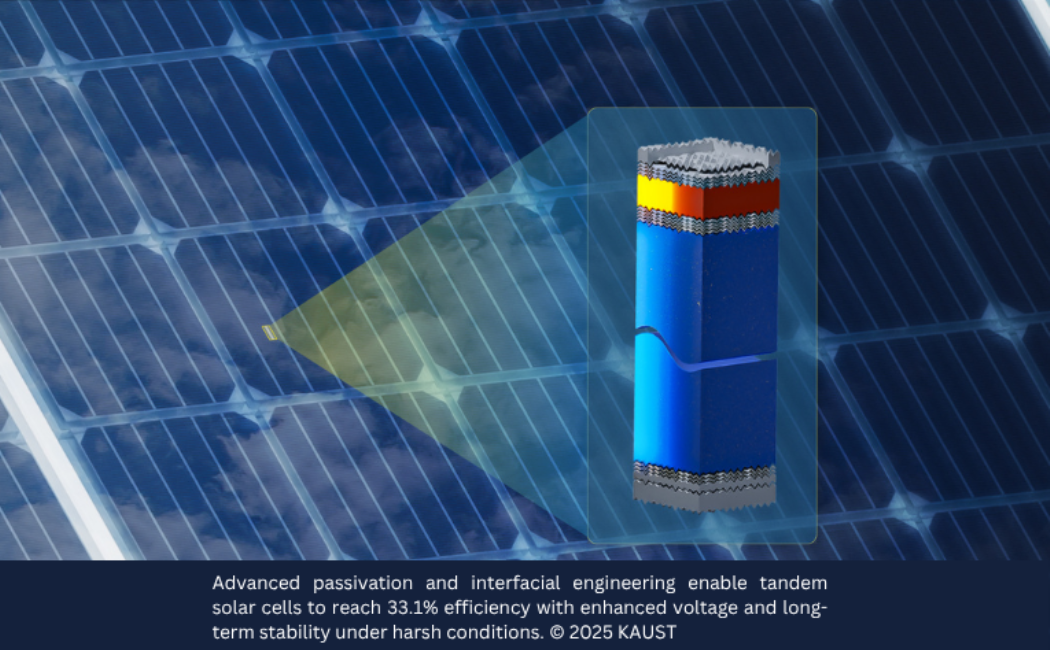


11 November, 2025
Improving the interfaces within perovskite/silicon tandem solar cells is a strategy that can boost solar performance and enhance stability. These key steps are important for bringing the advanced solar technologies closer to commercial viability and have now been developed by an international team of researchers from the Fraunhofer Institute in Germany and KAUST.
Silicon dominates the solar cell industry because of its stability and reliability. Perovskites are a cheaper and more accessible alternative for processing, exhibiting exceptional light-absorbing and electronic properties that have led to the development of high-efficiency devices. Their composition can also be tuned to enable light absorption in the green-to-blue wavelength range, a portion of sunlight that cannot be absorbed by silicon.
Combining these complementary materials in stacked, multilayered devices — known as tandem solar cells — can achieve the best of both worlds. Tandem solar cells that comprise an ultrathin perovskite film on top of a traditional silicon solar cell are expected to better harvest and convert sunlight into electricity than their subcells alone. Also, they are more cost-effective because they exploit industrially mature silicon technology.
Recent advances, such as maximizing light absorption and perovskite bulk crystallization, have pushed the power conversion efficiency of tandem solar cells over 29.4% — the theoretical maximum for silicon devices. Yet, interface-related challenges still limit cell performance.
When sunlight strikes the perovskite film, it creates pairs of electrons and positively charged holes. If there are any defects, these pairs tend to recombine at the interface between the perovskite and the electron-transport layer — which usually consists of the electron-acceptor C60 — before generating electricity.
This process of interfacial recombination reduces the maximum operating voltage, or open-circuit voltage, and the electrical performance of the tandem cells. A conduction band offset between the perovskite and C60 further depletes electrons at the interface, thereby enhancing recombination.
Several methods can help to address these interfacial problems, but these are ineffective for tandem cells using industry-standard textured silicon bottom cells with large pyramids on their surface.
Now, a team led by Stefan Glunz at the Fraunhofer Institute and Stefaan De Wolf at KAUST has developed a passivation approach that aims to reduce or eliminate defects, compatible with these fully textured silicon substrates. The approach is based on work-function engineering and uses 1,3-diaminopropane dihydroiodide as an interlayer material at the perovskite/C60 interface of the tandem cell.
The researchers produced an organic-rich perovskite film that conforms to the textured substrate by a two-step evaporation/spin-coating method. They treated it with the interlayer material before completing the tandem cell.
The interlayer material consists of two ammonium iodide functional groups bridged by a flexible hydrocarbon linker. Its structure enables it to bind asymmetrically to the perovskite surface. This generates a strong positive dipole moment that preferentially interacts with the organic-rich surface, increasing the work function —the minimum energy required for electron extraction.
Beyond conventional passivation, the interlayer material modulates the surface electrostatics by shifting the work function. The shift decreases the conduction band offset, allowing electrons to accumulate at the interface. “This suppresses interfacial recombination and improves electron transport across the entire perovskite film,” De Wolf explains.
Read more at KAUST Discovery.